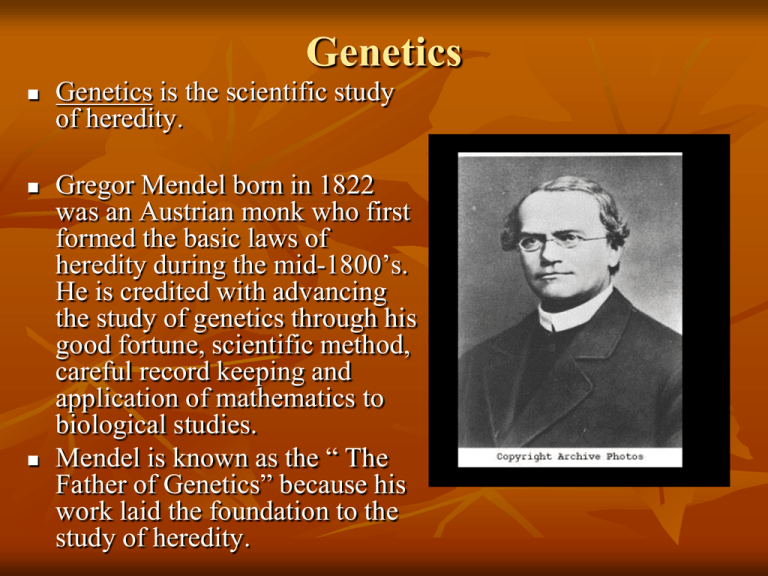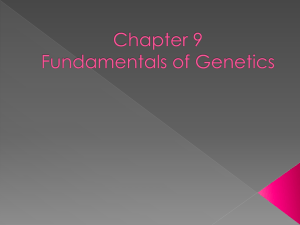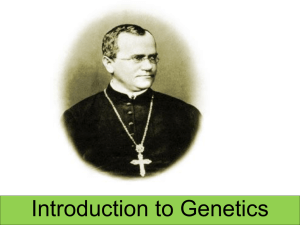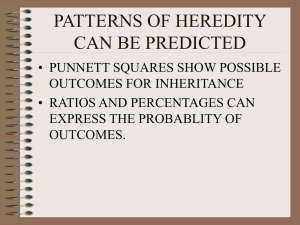
Genetics
Genetics is the scientific study
of heredity.
Gregor Mendel born in 1822
was an Austrian monk who first
formed the basic laws of
heredity during the mid-1800’s.
He is credited with advancing
the study of genetics through his
good fortune, scientific method,
careful record keeping and
application of mathematics to
biological studies.
Mendel is known as the “ The
Father of Genetics” because his
work laid the foundation to the
study of heredity.
The Good Fortune
Mendel inherited a purebred stock of peas that produced identical
offspring as a result of self pollination of pea plants. (male and female
parts on the same plant)
Mendel based his laws on his studies of the garden peas and was able
to observe differences in multiple traits over many generations
because pea plants reproduce rapidly
He chose to study seven traits with just two contrasting characters
(as opposed to intermediate forms)
Good Science
(Tall plants used as an example)
Mendel noticed that some plants
always produced offspring that
had a form of a trait exactly like
the parent plant. He called these
plants “purebred” plants.
Mendel cross pollinated purebred
plants with opposite forms of a
trait. He called these plants the
parental generation; or P
generation.
He called the offspring the F1
generation; or first filial and he
observed that they were all tall, as
if short trait had disappeared.
Good Science
(Tall plants used as an example)
Since the F1 offspring plants received
one tall and one short gene from the
parents plants then they are said to be
“hybrid” for that trait. (But why were
all the F1 plants tall if they had
inherited one tall gene and one short
gene?)
Mendel then crossed two of the
offspring tall plants produced in the
F1 generation.
He called this second generation of
plants the second filial; or F2
generation.
To his surprise he observed that this
generation had a mix of tall and short
plants even though none of the F1
parents were short.
Mendel’s Law of Segregation
Mendel’s first law, the Law of Segregation, has three parts.
From his experiments he concluded:
1.
Plant traits are handed down through “hereditary
factors” in the sperm and egg.
2.
Because offspring obtain hereditary factors from both
parents, each plant must contain two factors for every
trait.
3.
The factors in a pair segregate (separate) during the
formation of sex cells (meiosis), and each sperm or egg
receives only one member of the pair.
We now call the “hereditary factors” genes.
Dominant and Recessive Genes
In the first experiment when
Mendel crossed a purebred tall
with a purebred short, all the
offspring were tall.
Mendel reasoned that one factor
(gene) in a pair may mask, or hide,
the other factor.
Although the F1 offspring all had
both tall and short factors, they
only displayed the tall factor
He concluded that the tallness
factor masked the shortness factor.
Dominant and Recessive Genes, cont.
Today scientists refer to factors that control traits as
genes.
The different forms of a gene are called alleles.
Dominant alleles are the alleles that mask or hide
other alleles, such as the tall allele.
Recessive alleles, such as the short allele, that are
masked, or covered up (hidden), whenever the
dominant allele is present.
Mendel’s Principle of dominance states that one
factor in a pair may prevent the other from being
expressed. The dominant gene masks the expression
of the recessive gene.
P generation plants in this experiment were both
purebreds with the same type of gene
TT (tall ) and
tt (short)
Capital letter of the dominant trait is used for the
dominant factor and the lower case letter is used for
the recessive trait
The purebred dominant is called
homozygous dominant-TT
The pure bred recessive is called
homozygous recessive- tt
The F1 plants in this study had one factor from each
purebred parent and are called heterozygous - Tt or
hybrid
To explain the expression of traits in the F2 plants
Mendel developed two more principals
The principle of segregation states that the members
of each pair of genes separates ,or segregate, when
gametes are formed
The principle of independent assortment states that
two or mores pairs of genes segregate independently
of one another during the formation of gametes.
The process of meiosis is the mechanism for these
principles
More Terms
Allele is the term used to describe either member of a pair of
genes that determines a single trait.
T is the dominant allele
t is the recessive allele
Genotype is the genetic makeup of the organism. It’s genetype (genes it received)
Phenotype is the trait that’s actually expressed in an
organism’s appearance. (physical appearance)
I t is important to note that Mendel made all
his observations, developed his experimental
methods and mathematical conclusions before
detailed knowledge of cell structure and
division had been discovered .
Genetics and Probability
Probability – is the likelihood that
a particular event will occur.
Example: If you flip a coin it may
land heads up or tails up. The
chance, or probability, of either
outcome are equal. Therefore, the
probability that a single coin flip will
come up heads is 1 chance in 2 , that
is ½ , or 50%.
If you flip the coin 3 times in a row
the probability each time is still ½
So ½ X ½ X ½ = 1/8
The principles of probability can
be used to predict the outcomes of
genetic crosses.
Punnett Square
Developed in the early
1900’s by Reginald
Punnett, the Punnett
square is a useful tool
in visualizing the
outcome of various
types of gene
combinations.
Monohybrid Cross
A monohybrid cross is
one involving just one
trait
A dihybrid cross
involves two traits
In a test cross the
unknown genotype
of a dominant
phenotype can be
determined by
crossing it with a
homozygous
recessive
(recessive
phenotype)
Genetics and Probability
The genotypic
ratio for the F2
offspring is just
like our coins
1:2:1
The phenotypic
ratio is 3:1
Genetics and Probability
The phenotypic ratio for the F2 offspring in a
dihybrid cross is 9:3:3:1
Steps To Working Genetic Crosses
1. Set up A Legend
2. Set-up Parental Genotype.
3. Construct a Punnett
Square
4. Align Parentals Genotype
5. Fill in Punnett Square.
6. Record Results.
1.) Setting Up A Legend
A legend is an explanatory list of the
symbols on a map or chart
Setting Up A Legend
Your legend for genetic
crosses will show both
the phenotype and
genotype.
The Phenotype
(Physical appearance)
will be on the left.
The Genotype (genetic
make-up) will be on the
right.
Tall
= TT Tt
Short
=
tt
(phenotype) (genotype)
or
Red = RR Rr
White = rr
2.) Set-up parental genotypes
Write down your
"cross"(mating).
Write the
genotypes of the
parents in the
form of letters
Tt x tt
3.) Setting Up A PUNNETT SQUARE
When given enough
info about two
parent organisms,
we can use this
window pane to
predict the
genotypes &
phenotypes of their
offspring.
4.) Align Parentals Genotype
1st Parent
Take the
genotype letters
of one parent,
split them and
put them on the
left, outside the
rows of the
punnett square
Align Parental Genotype
2nd Parent
Now take the two
letters of the second
parent's genotype,
split 'em up, and
place them above
each of the two
columns of the
punnett square.
Fill in Punnett Square
Filling in the top-left box:
One from the
left, one from
the top.
Filling in the bottom-left box:
One from the
left, one from
the top.
Filling in the top-right box:
One from the
left, one from
the top.
Filling in the bottom-right box:
One from the
left, one from
the top.
5.) Record Results
Show Phenotype and
Genotype in your
results
Phenotype: Show the
results as Percent (%)
and ratio.
Genotype: Show the
results for each different
genotype.
Phenotype: 50% Tall,
50% Short (2:2)
Genotype: 2Tt, 2tt
It was Walter Sutton in 1903 who made
the link between Mendel's principles and
his own observation of meiosis in
grasshoppers.
The chromosome theory he proposed
states that hereditary factors or genes, are
carried on chromosomes.
The pairing of homologous chromosomes
followed by their independent
segregation during meiosis explained all
of Mendel's observations.
Dihybrid Crosses: Setting Up
Punnett Square
Go to Dihybrid pwpt
Incomplete Dominant Crosses
Not all Phenotypes are the
result of dominant or
recessive genes .
Incomplete Dominance is the
incomplete expression of the
dominant allele in a
heterozygote, where both
alleles are expressed in the
phenotype.
That is, there is a blending of
traits where the alleles act
together to yield an
intermediate phenotype
Flower Color in Snapdragons:
Incomplete Dominance
Red flowers - two alleles allow them to make
a red pigment
White flowers - two mutant alleles; can’t
make red pigment
Pink flowers - have one normal and one
mutant allele; make a smaller amount of
red pigment
Flower Color in Snapdragons:
Incomplete Dominance
Red-flowered plant X White-flowered plant
(homozygote)
(homozygote)
Pink-flowered F1 plants
(heterozygote)
Flower Color in Snapdragons:
Incomplete Dominance
Pink-flowered plant X Pink-flowered plant
(heterozygote)
(heterozygote)
White-, pink-, and red-flowered plants
in a 1:2:1 ratio
R = allele for red flowers
W = allele for white flowers
red x white ---> pink
RR x WW
Phenotype: 0% Red,
100% Pink, 0% White
(0:4:0)
(R:P:W)
Genotype: 4RW
Legend:
Red = RR
White= WW
Pink= RW
Non Mendalian Genetics
Codominance
is a condition
when both
alleles are
expressed
neither one is
dominant BBxWW = BW
Example of Co-Dominance
Black\white spotted
crossed with
Multiple Allele Traits
Many traits have more then two alleles in the
population
One important multiple allele trait is blood type
Type A is Codominant with type B
Type O is recessive to both A and B
Resulting in: Type A = AA or AO
Type B = BB or BO
Type AB = AB
Type O = OO
Human ABO Blood Groups
Gene “I” specifies which sugar is found on the
outside of red blood cells
3 common alleles are present in the human population:
IA = N-acetyl-galactosamine
IB = galactose
i (also referred to as o) = no sugar present
6 possible genotypes
AA
AO
I A IA
IA i
BB BO OO AB
or
IBIB IBi ii IAIB
Immunology 101
Sugar on the blood cell is an antigen* (A, B, A and
B,
or none)
Your immune system thinks your own antigens
are fine
Your immune system makes antibodies against
non-self
antigens
Antibodies recognize and target cells with antigens
for
destruction
*something that elicits an immune response
Legend:
Type A = IAIA or IAi
Type B = IBIB or IBi
Type AB = IAIB
Type 0 = ii
Example: IAi x IAIB
IA
Phenotype = 50% Type A;
25% Type AB; 25% Type B
0% Type O
IB
(2:1:1:0)
(A:B:AB:O)
Genotype = 1IAIA; 1IAi; 1IAIB; 1IBi
IA
i
IAIA
IAi
IAIB
IBi
Polygenic Traits
Polygenic traits are those traits that are
determined by several genes.
Examples of these are skin color, eye color and
height
Drosophila melanogaster
Thomas Hunt Morgan working with genetics most
famous animal, the fruit fly ,was the first to
demonstrate that a specific gene was located on a
specific chromosome.
The Sex Chromosomes
Nettie Stevens was the first to propose
that the odd smaller Y chromosome that
paired with the X determined an
organism's sex.
To be
male you must have
an X and a Y to be
female you need two X’s.
50% chance of Male, 50% chance of Female
The Sex Chromosomes
The mismatched
chromosomes are called
the sex chromosomes.
(note the smaller size of
the Y)
All the other (usually
homologous)
chromosomes are called
autosomes.
Sex linked Traits
A sex linked trait is one determined by alleles carried
only on the X chromosome
A sex linked trait has no corresponding allele on the
Y chromosome.
Sex-Linked Traits
As with all organisms
humans have traits that are
only carried on the X
chromosome.
Examples of these are
colorblindness and
hemophilia, a disorder that
prevents normal blood
clotting
Gene linkage is a situation in which two or more
genes occur on the same Chromosome and are thus
inherited together.
Crossing over is the exchange of alleles between two
homologous chromosomes ( it is a useful tool in gene
mapping)
Sex-linked Traits
Traits (genes) located on the sex
chromosomes
Example:
fruit flies
(red-eyed male) X (white-eyed female)
Sex-linked Traits
Notice there is
no gene on the
Y chromosome
Sex Chromosomes
fruit fly
eye color
XX chromosome - female
XY chromosome - male
Example:
fruit flies
(red-eyed male) X (white-eyed female)
XRY * XrXr
Remember: the Y chromosome in males does not carry
traits.
R
X
Y
Legend:
red eyed= RR Rr
white eyed= rr
Male= XY
Female= XX
Phenotype
50% red eyed and female
50% white eyed and male
Xr
XRXr
Xr
XRXr
XrY
XrY
Genotype
2 XRXr, 2 XrY
PEDIGREE CHARTS
Pedigree charts show
a record of the family
of an individual. It can
be used to study the
transmission of a
hereditary condition. It
is particularly useful
when there are large
families and a good
family record over
several generations.
= males and O = females
•
Autosomal Pedigrees
An autosomal pedigree
is probably one of the
most common pedigrees
that you will find. If a
(recessive) trait is
inherited on any
chromosome except for
the sex chromosomes
(X or Y), then you are
studying an autosomal
pedigree.
Symbols used in pedigree charts
In a marriage with five children,
two daughters and three sons.
The second son is affected by
the condition.
Above is a pedigree chart of a family showing
four generations.
A total of 20 individuals.
Sex Linked Pedigrees
A sex linked pedigree
deals with a trait that is
found on the X
Chromosome. Since
males are XY, they will
only carry one allele;
therefore the allele that
they possess will directly
be reflected in the
genotype. Females, on the
bother hand, are XX, so
they carry two alleles per
trait. A female who is
heterozygous for a sexlinked trait is said to be a
carrier.
Symbol
Meaning
Dominant Male
Dominant
Female
Recessive Male
Recessive
Female
Carrier Female
(for a sex-linked
trait)
Human Genetics
A pedigree is a graphical representation of a
genetic inheritance
Key
Key
Tay Sachs Disease
Key










